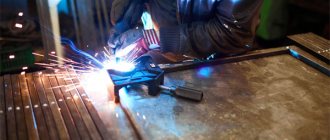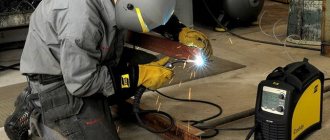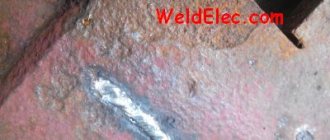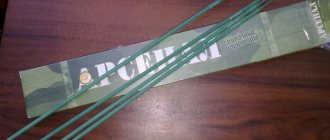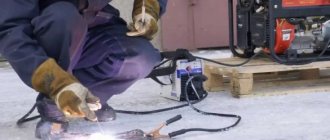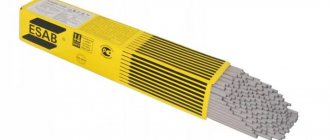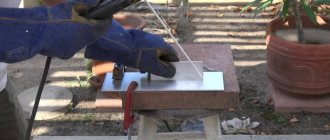What is an electrode: device
This is a rod made of metal or other electrically conductive composition. It ensures the supply of current from the device to the object that requires welding. The elements come in different lengths: from 25 to 45 cm. Each of them has a protective coating. It prevents the oxidation process. Only a small part of the consumable remains “bare” - the part that is inserted into the holder. Therefore, when searching for components, it is important to consider their thickness. Three-millimeter ones are considered the most popular. Options of 1 and 2 mm are less popular among specialists. Thin ones are used with steel sheets and other parts that require a jewelry approach. You can easily find five-millimeter elements in stores, but beginners rarely need them. Rods with an end larger than 3 mm are needed for alloys that form thick sheets. To work with them, you need a high-power device, which not every beginner has. The variety of choices makes you wonder how to choose the right welding electrodes for an inverter and select their diameter according to the thickness of the metal for high-quality welding. We recommend that you be guided by the following principle: compare the values on the components and the material you plan to deal with. For example, for 2mm metal sheets, use 2mm rods.
Thickness
Types of electrodes for manual arc welding are divided according to the thickness of the coating, which depends on the diameter of the internal rod. However, the division is carried out not on the exact dimensions, but on the relationship between them.
Thin coating is designated by the letter "M". The thickness of the coating is 20 percent of the diameter of the rod. Medium coverage is designated by the letter “C”. This is the most common option. The thickness of the coating is 45 percent of the diameter of the rod.
Thick coating is designated by the letter “D”. The thickness of the coating is 80 percent of the diameter of the rod. Over 80 percent has a particularly thick coating, designated by the letter “G.” The correct choice of cross-sectional size is also important. It depends on the thickness of the prepared edges of the products being joined.
Classification of consumables
| by appointment | designation | |
| for carbon and alloy structural steels with a tensile strength of up to 600 MPa | e38, e42, e42a, e46, e46a, e50, e50a, e55, e60 | at |
| for alloyed structural metals with a tensile strength of more than 600 MPa | e70, e85, e100, e125, e150 | l |
| for heat-resistant materials that have undergone alloying | e09m, e09mkh, etc. | T |
| welding of high-alloy parts with special properties | e12x13, e06x13m, e10x17t, etc. | V |
| surfacing of surface coatings with special characteristics | e10g2, e11gz, e16g2khm, etc. | n |
Identifying common groups among a great variety of options is a difficult task, which not all experienced craftsmen undertake. They are schematically divided according to their purpose, the chemical composition of the fused alloy, types, thickness, material from which they are made, and mechanical properties. Experienced specialists use those consumables that they are used to, or those that satisfy them in terms of price and quality ratio. When choosing, they usually take into account two criteria:
- The type of metal you will need to work with. If welding work is carried out at home, then most often we are talking about iron and alloys based on it - the so-called ferrous ones. In this case, the only thing a beginner should consider is the carbon content. Find out what kind of steel you will be dealing with: high, medium, low carbon or cast iron. Acquaintance also often has to start with “stainless steel”.
- Design requirements. Before deciding which electrodes to choose for inverter welding and how, it is necessary to understand whether the seams will be subject to vibration loads or temperature changes. In this case, you should pay attention to rods with enhanced properties.
Japanese Kobelco LB-52U
Electrodes of a Japanese company
The price of the rods, like any Japanese technological product, is very high. Electrodes are sold by the kilogram, but they are packaged at least 4 kg. for one package. The quality of the products corresponds to the prices. Connections are made between low-carbon steels in pipelines where double-sided welding is not possible. Work with incredibly high performance will be accepted by the most fastidious expert commission. And , no one has any questions about which electrodes are better.
Proves positive aspects:
- strong and clean seam;
- perfect welding of any complexity of material;
- creating a weld stitch in any direction.
The price serves as both a disadvantage of the product and an obstacle to purchase. Products are content sensitive. They are stored in dry warehouses. If the electrodes become damp, they will have to be dried by baking before they are used.
Classification by type of coating
There are 4 options:
Basic or calcium fluoride
Identified by the letter "B". It consists of calcium and magnesium carbonates. It may contain marble, magnesite, dolomite. These elements have a low oxidizing ability, due to which the process of removing oxygen from the molten metal is faster. The second name appeared due to the fact that the slag diluent is natural calcium fluoride - fluorite. The advantage of calcium fluoride electrodes is their low hydrogen content. This factor allows you to obtain a strong seam, without gases and impurities, and also minimize the risk of hot cracks. Consumables with a main protective layer are ideal for pipelines carrying hydrogen sulfide compounds, as they resist cracking well. But there is also a nuance. Everything must take place with a direct current of reverse polarity, since calcium fluoride inhibits the operation of components with alternating voltage and the welding arc may burn unstably. Choose electrodes with this type of coating if you plan to work with steel with a high sulfur content or a material that must withstand heavy loads or will be regularly exposed to high temperatures. They are also suitable for welding rigid structures.
Rutile
Despite the fact that a different type is called “main”, this is the option used in 95% of works. The gas released during combustion is non-toxic, so this is the safest solution for the health of the master. The metal seam made with the concentrate is resistant to cracks, does not bend or break, since the consumable material increases viscosity. This coating is ideal if the welder works with a short seam, because the arc burns well even if the voltage in the network fluctuates. For people who have not yet developed their hand and cannot hold it throughout the entire work process, this is the best option. In addition, you can operate with it in any spatial plane.
Sour
Suitable if welding work needs to be accelerated by forcing or lengthening the arc discharge. This is the most toxic type. Due to the increased level of splashing, it can only be interacted with in the lower position. It should not be used for high-temperature calcination. Not recommended for beginners.
With cellulose coating
Half consists of organic compounds - flour, starch, cellulose, half of natural and synthetic silicates. These are very thin consumables, so they can be used in any plane. With their help, a seam is created very easily, which increases the speed of completing the task several times, but the surface of the seam is uneven and requires grinding. Choose cellulose coating if you have to work with carbon and low-alloy steels. It is also suitable for hard-to-reach structures, since the diameter of such elements is minimal.
| type (designation in marking) | stamps |
| main (b) | uoni-13/45, uoni-13/45a, uoni-13/45, uoni-13/45a, uoni-13/45r, tmu-46, uoni-13/55, uoni-13/55k, uoni-13/ 55s, uoni-13/55u, uoni-13/55r, uoni-13/65, ozs-22r, 55-u, fno-t, fno-tm, fno-tm/n, its-4, its-4s, OZS-18, etc. |
| sour(s) | omm-5, cm-5, mez-4, etc. |
| rutile (r) | ano-21, ano-21m, ano-36, ozs-4, ozs-12, ozs-30, ozs-32, etc. |
| cellulose (c) | vsts-4, vsts-4m, oma-2, vsts-4a, etc. |
| mixed: carbonate-rutile (rb) | ozs-28, ano-3, ano-4, etc. |
| rutile-carbonate-fluoride | ozl-9a, etc. |
| ilmenite | ozs-41, mr-3u, mr-3r, etc. |
| rutile-cellulose (rc) | ano-13, fno-29m, etc. |
| acid-rutile (ar) | ano-6, ano-6m, ano-17, ozs-23, ano-24, etc. |
| rutile-ilmenite | mr-3m, etc. |
| with iron powder (g): rutile with powder filler (rzh) | ozs-6, ano-1, ano-27, uoni-13/55tzh, etc. |
| other (n) | for cast iron, non-ferrous alloys, salt. |
Russian welding rods
This is what it looks like in design
If you have a good inverter machine, nothing will stop the master from welding steel even with nickel and chromium, or domestic OZL-8 electrodes. Stainless steel can only be welded with such rods, provided that the welding operates on direct current with reverse polarity and a short arc. Compliance with the requirements will ensure the strength of the seam without heating.
OZL8
OZL-8 rods are used when processing highly loaded units if they are planned to be used with an alternating load.
It is impossible to weld parts without slag, but it is easy to remove. After the work has cooled, the connection does not crack, but there is no need to forcefully influence the process to prevent crystallization, which will reduce the strength. Calcination is carried out by reaching a high temperature, so time is wasted on ignition.
Positive properties:
- the seam is easy to make;
- high-load units can be welded;
- no deformations after chipping off excess formations;
- Recommended for use on stainless steel.
Despite the Russian production, the cost of the electrodes is significant, if we take into account that a humid environment worsens the characteristics of the product.
How to choose electrodes for welding with an inverter
Metal diameter and thickness
Compare these two criteria. They should be approximately the same. For inverter equipment, rods up to 2 mm are usually taken, because they are not suitable for larger orders.
Purpose
There are many subtleties. The choice depends on the work technology you will use, welding equipment, and source material. Universal advice - don’t chase cheap offers. Of course, a master can perform a task efficiently using any means at hand, but you should pay attention to mid-price options that minimize mistakes and won’t break your pocket.
Which electrodes are best for cooking: choose by type of metal products
Fence
Consumables with rutile coating are a win-win for a beginner. This is AHO with numbers 4,6, 21, 36., MP-3, OK-4600. You can also take rods of mixed recipes “Monolith”, “Granite”, “Arsenal”. The advantage is easy initiation of the electric arc. You will be able to weld with a tear, and pores will not form in the seam. Effective when you need to quickly erect a multi-meter structure.
Thin metal
To avoid burning holes, look for elements with a minimum diameter: we have already discussed how to choose the right electrode for welding above - correlate it with the thickness of the sheet.
Pipes
Gas is treated with grades OK-46 and LB-52. For the heating system, purchase E42A, UONI-13/45, for water supply - MN-5 and MNZh5.
Channel
It all depends on the size of the part. If they are small, then he chooses five or six millimeter ANO-21. You can even cook rusty surfaces with them. If the dimensions of the channel are impressive, only UONI-13/55U. They do not limit the master: alternating and direct current, reverse and direct polarity.
Rails
Experts recommend brands UONI-13/45 and UONI-13/55.
Choosing electrodes for welding with an inverter for beginners: how and which ones to choose by type of metal
Very often, at home, the main criterion that guides a novice welder is the material.
Stainless steel
This is one of the most frequently used components, so consumables for it are even included in a separate group. For manual use, take the TsL-11 - it is a reliable and easy-to-use option.
Cast iron
It also has its own group of consumables. They are nickel, copper and iron-copper-nickel. Give preference to the OZCH brand. For a malleable alloy, product numbers 2 and 6 are suitable, for a cast alloy – 1 and 3.
Armature
Products with rutile or basic coating ANO-21 are suitable for this.
Galvanization
Popular products made from this material are UONI 13/55, TsU-5, TsL-20, TMU-21.
Copper
Special consumables for ductile metal – OZB-2M and ANTs/OZM-2.
How to choose the best electrodes for inverter welding
Experienced professionals recommend the following brands:
Calcium fluoride coating
- ESAB;
- SSSI 13/55.
Rutile layer
- AHO-4;
- MP-3;
- OK 46.00.
Stainless steel
- NZh-13;
- OZL-8;
- TsL-11.
We told you how a novice master can choose suitable consumables, gave instructions on which options to choose if you cannot yet assess the situation from the height of your own experience, and told you how to choose a certain electrode diameter. We hope our recommendations will allow you to do the job efficiently and help you further improve your skills. is engaged in the sale of bandsaw machines; for individual consultation, please contact our managers at the contact numbers listed on the page.
Quality ANO-4
This universal brand is produced by a Russian manufacturer
Calcination lasts an hour when heated to
180 deg. weld elements with short and long arcs. The rods are recommended for use for serious structural fixations, regardless of position (except vertical). A good inverter device can be connected to direct and alternating current to work with the ANO-4 brand. The result is of excellent quality, reliable and without defects.
No matter how prestigious and expensive the brand of rod may be, in each of them, after listing all the advantages, sometimes there is only one drawback - poor resistance to moisture. Even if it is dried and calcined, it will still not be possible to completely restore the electrode to its previous state. If you have spent money on a core, an important element for making an even, high-quality seam and obtaining a structure without flaws, you need to take care of proper storage. Place the packages in a separate room, which is equipped for long-term maintenance of the kits.
The room intended to contain electrodes must be dry and heated in the cold season. Temperature fluctuations are also excluded; ideally, a stably heated room should be maintained at +18 degrees. With air conditioning, it is possible to set the optimal limit without jumps in temperature. It is more difficult to create conditions with underground storage. In these rooms, ventilation and high-quality waterproofing are monitored, and excess moisture is prevented from entering.
Cardboard packaging is being replaced with plastic packaging as paper attracts moisture
If the device with electrodes is in the garage in winter, while there is no welding work, the rods are transferred to a heated house, placing them in a special case.
Until the box is replaced, the electrodes are not placed on open ground, even temporarily.
